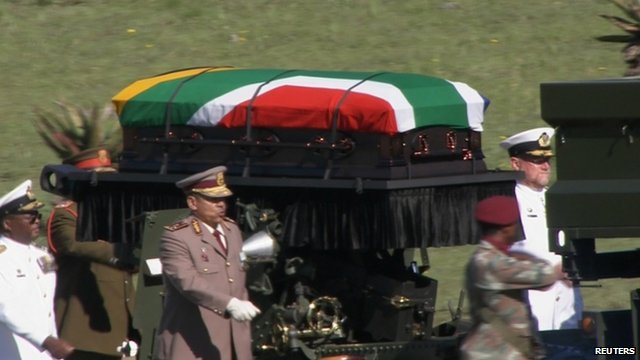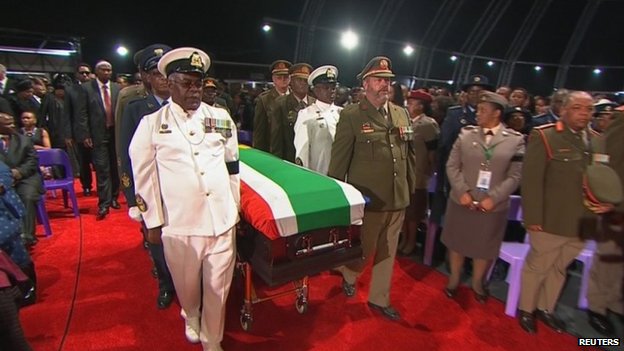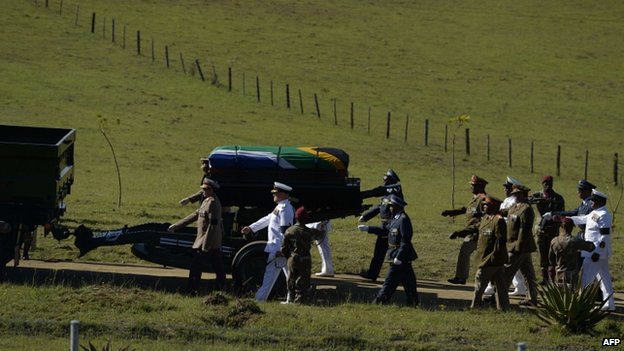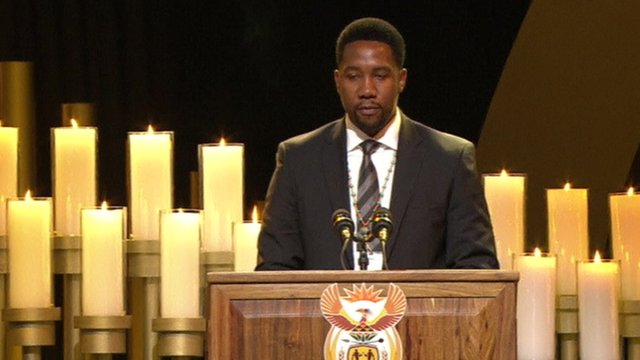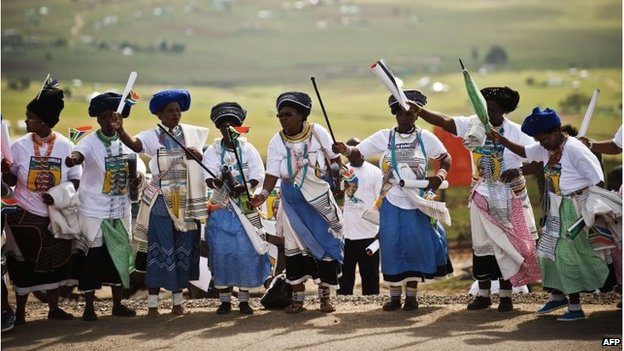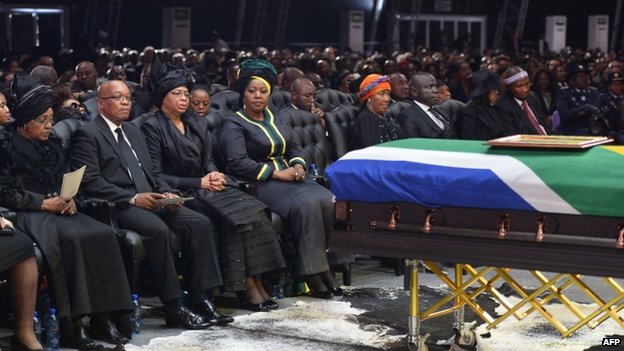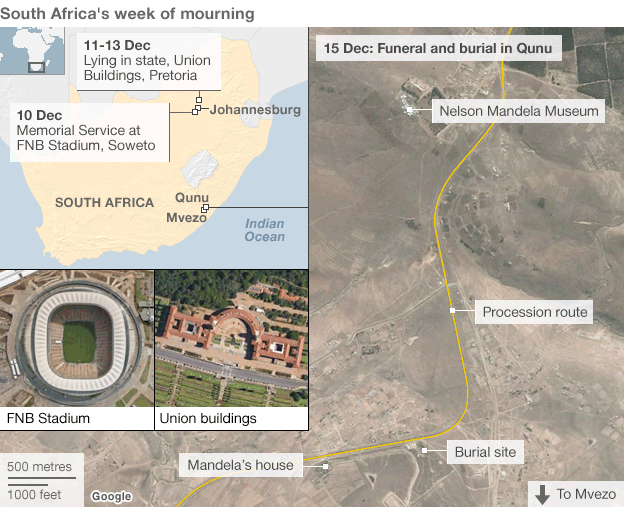Nelson Mandela’s state funeral is under way at his ancestral home in Qunu, ending a week of commemorations for South Africa’s first black leader.
Some 4,500 people – including foreign dignitaries – are attending the service, which blends state ceremonial with traditional rituals.
A close friend, Ahmed Kathrada, told the service he had lost an “elder brother” who was with him for many years in prison on Robben island.
Mr Mandela died on 5 December aged 95.
The coffin of Nelson Mandela was brought into the marquee for the service
Members of his family attended an overnight vigil, with a traditional praise singer believed to be chanting details of his long journey and life.
Nelson Mandela always said he wanted to be buried in his childhood home of Qunu
The coffin was taken on a gun carriage from Mr Mandela’s house to a giant white marquee that had been specially erected.
Analysis
Clear skies in the small village of Qunu but a heaviness in the air. A mournful start to the final goodbye to Nelson Mandela.
His coffin, draped in the South African flag, made its way into the large white marquee where thousands were waiting to bid him farewell.
It is a state funeral the like of which South Africa has never seen. There is a sombre mood here as funeral songs ring out. “Lizalise idinga lakho”, which means “fulfil your promise, Lord”, was one of Mr Mandela’s favourite church hymns.
One of Mr Mandela’s closest friends Ahmed Kathrada said his life was in a “void” now that Mr Mandela was gone. “I have no one to turn to,” he said.
After the State funeral, he will be handed over to local chiefs for a private ceremony which will end in the salute “Ah, Dalibhunga” – the final goodbye.
Inside the marquee, Nelson Mandela’s portrait had been placed behind 95 candles, representing one for each year of the late president’s life.
His casket, draped in the South African flag, was placed beneath a lectern where speakers paid their tributes. Some guests sang and danced to celebrate Mr Mandela’s life as the service began.
After the national anthem, Nkosi Sikelel’I Africa (God Bless Africa) was sung, the service heard from a family spokesman, Chief Ngangomhlaba Matanzima, who thanked the army medical team that had treated Mr Mandela before he died.. “A great tree has fallen, he is now going home to rest with his forefathers. We thank them for lending us such an icon.”
Mr Kathrada’s voice filled with emotion as he spoke of the difficulty of recent months and of how he had held his friend’s hand the last time he saw him in hospital. “Farewell my dear brother, my mentor, my leader,” he said.
Two grandchildren then addressed the congregation. Ndaba who read an obituary, and Nandi, who spoke fondly of her grandfather as a disciplinarian. “We shall miss you… your stern voice when you are not pleased with our behaviour. We shall miss your laughter.”
Listening to the tributes were Graca Machel, his widow, and his second wife, Winnie-Madikizela Mandela, who sat either side of President Jacob Zuma.
Both women were praised for their love and tolerance, in an address by Malawi’s President Joyce Banda.
African National Congress members, veterans of the fight against apartheid and foreign dignitaries – including several African presidents, the Prince of Wales – are among the guests.
Archbishop Desmond Tutu – a long-time friend of Nelson Mandela – is there, having earlier said he had cancelled his flight as he had not received an invitation. US talk show host Oprah Winfrey is also present.
President Zuma, who was booed at last week’s stadium commemoration in Soweto, then led the service in song before giving his funeral oration.
“It has been a long and painful week for us,” he said in tribute to a man he praised as a pillar of strength and beacon of hope for anyone fighting for a “just world order”.
“Whilst the long walk to freedom has ended in the physical sense, our own journey continues,” he said.
After the two-hour service, Mr Mandela’s Thembu community will conduct a private traditional Xhosa ceremony – including songs and poems about Mr Mandela’s life and his achievements.
An ox will be slaughtered. A family elder will stay near the coffin, which has been draped with a lion’s skin, to talk “to the body’s spirit”.
The burial will bring to an end 10 days of mourning across South Africa.
‘Sad but happy’
On Saturday, Mr Mandela’s coffin was flown from Waterkloof airbase in Pretoria on a C130 military aircraft, escorted by two fighter jets. It later landed at Mthatha airport, some 700km (450 miles) away.
In line with tribal custom, Nelson Mandela’s grandson Mandla accompanied him on the journey, speaking to his coffin to tell him he was on his way home to rest.
To solemn music, the coffin was moved by a military guard of honour and placed in a hearse to begin the 32km journey to Qunu, where Mr Mandela had wanted to spend his final days.
Crowds waving flags and cheering and singing lined the route taken by the cortege through Mthatha town to pay their last respects.
Xhosa funeral rituals
- A family elder talks to “the body’s spirit”
- The coffin is covered with a leopard’s or lion’s skin
- An ox is slaughtered and eaten on the day
- Another ox to be slaughtered next year to mark the end of mourning
The cortege then drove through the gates of the Mandela homestead in Qunu.
Ahead of the flight to the Eastern Cape, members of the African National Congress paid final tributes to Nelson Mandela at a ceremony in Pretoria.
President Zuma, other ANC leaders and more than 1,000 members of the organisation which Mr Mandela once led, attended the event at the Waterkloof air base.
At least 100,000 people saw the former president’s body lying in state for three days in Pretoria, but some had to be turned away.
South Africa’s Jacob Zuma (second left) is one of several African leaders paying their last respects to Mr Mandela.
Many people walked to watch the funeral on the Mandela family’s property in Qunu.
Are you in South Africa?

